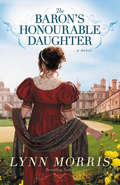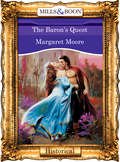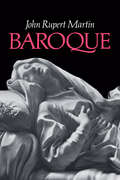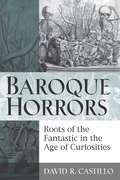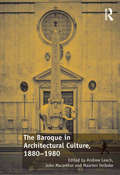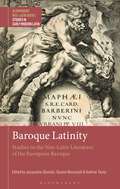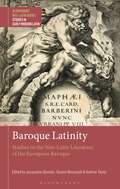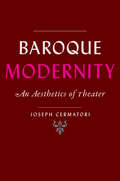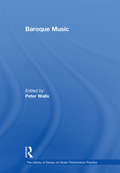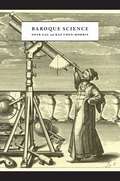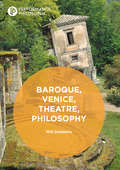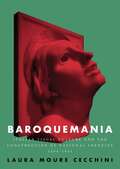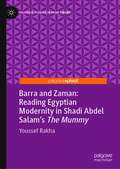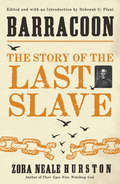- Table View
- List View
The Baron's Honourable Daughter: A Novel
by Lynn MorrisBestselling author Lynn Morris weaves an inspirational Regency era romance rich in period detail.When her stepfather suddenly dies, Valeria Segrave finds she must take charge of her grieving mother and the vast estate which now belongs to her six-year-old half brother, the new Earl of Maledon. Though capable, Valeria is frustrated to find each day brings a new struggle as she tries to establish her authority with servants, stewards, and solicitors-all men. As a young woman with no blood relation to the earl, they are all too ready to dismiss her. Much to her chagrin, she must rely on the assistance of her stepfather's distant kinsman, Alastair, Lord Hylton. He is handsome and noble, and Valeria senses under the veneer of his gentlemanly behavior that she never measures up to his expectations of a refined lady. In light of that, accepting his help and feeling under a burden of gratitude to him is almost unbearable. Even when Valeria leaves the country estate for the glittering London Season, where she gets into a series of escapades, Lord Hylton is always there to witness, criticize, and correct her behavior. But if Alastair insists on engaging in a battle of wits and wills with the lively Valeria, she'll stop at nothing to prove that he's met his match.
The Baron's Quest (Mills And Boon Vintage 90s Modern Ser.)
by Margaret MooreThe Baron DeGuerre Had Finally Met His Match Though famed for prowess in tourney and war, Etienne DeGuerre now found himself at odds in the Battle of the Sexes. For his opponent, Gabriella Frechette, was a woman of singular beauty… and single-minded resolve. One who had easily stormed his defenses, and laid siege to his unsuspecting heart
Baroque (Icon Editions Ser.)
by John Rupert MartinThis is a nonchronological introduction to Baroque, one of the great periods of European art. John Martin's descriptions of the essential characteristics of the Baroque help one to gain an understanding of the style. His illustrations are informative and he has clearly looked with a fresh eye at the works of art themselves. In addition to the more than 200 illustrations, the volume contains an appendix of translated documents.
Baroque
by John Rupert MartinThis is a nonchronological introduction to Baroque, one of the great periods of European art. John Martin's descriptions of the essential characteristics of the Baroque help one to gain an understanding of the style. His illustrations are informative and he has clearly looked with a fresh eye at the works of art themselves. In addition to the more than 200 illustrations, the volume contains an appendix of translated documents.
Baroque Horrors: Roots of the Fantastic in the Age of Curiosities
by David Castillo"David Castillo takes us on a tour of some horrific materials that have rarely been considered together. He sheds a fantastical new light on the baroque." ---Anthony J. Cascardi, University of California Berkeley "Baroque Horrors is a textual archeologist's dream, scavenged from obscure chronicles, manuals, minor histories, and lesser-known works of major artists. Castillo finds tales of mutilation, mutation, monstrosity, murder, and mayhem, and delivers them to us with an inimitable flair for the sensational that nonetheless rejects sensationalism because it remains so grounded in historical fact." ---William Egginton, Johns Hopkins University "Baroque Horrors is a major contribution to baroque ideology, as well as an exploration of the grotesque, the horrible, the fantastic. Castillo organizes his monograph around the motif of curiosity, refuting the belief that Spain is a country incapable of organized scientific inquiry." ---David Foster, Arizona State University Baroque Horrors turns the current cultural and political conversation from the familiar narrative patterns and self-justifying allegories of abjection to a dialogue on the history of our modern fears and their monstrous offspring. When life and death are severed from nature and history, "reality" and "authenticity" may be experienced as spectator sports and staged attractions, as in the "real lives" captured by reality TV and the "authentic cadavers" displayed around the world in the Body Worlds exhibitions. Rather than thinking of virtual reality and staged authenticity as recent developments of the postmodern age, Castillo looks back to the Spanish baroque period in search for the roots of the commodification of nature and the horror vacui that accompanies it. Aimed at specialists, students, and readers of early modern literature and culture in the Spanish and Anglophone traditions as well as anyone interested in horror fantasy, Baroque Horrors offers new ways to rethink broad questions of intellectual and political history and relate them to the modern age. David Castillo is Associate Professor and Director of Graduate Studies in the Department of Romance Languages and Literatures at the University at Buffalo, SUNY. Jacket art: Frederick Ruysch's anatomical diorama. Engraving reproduction "drawn from life" by Cornelius Huyberts. Image from the Zymoglyphic Museum.
The Baroque in Architectural Culture, 1880-1980
by Andrew Leach John MacarthurIn his landmark volume Space, Time and Architecture, Sigfried Giedion paired images of two iconic spirals: Tatlin’s Monument to the Third International and Borromini’s dome for Sant’Ivo alla Sapienza. The values shared between the baroque age and the modern were thus encapsulated on a single page spread. As Giedion put it, writing of Sant’Ivo, Borromini accomplished 'the movement of the whole pattern [...] from the ground to the lantern, without entirely ending even there.' And yet he merely 'groped' towards that which could 'be completely effected' in modern architecture-achieving 'the transition between inner and outer space.' The intellectual debt of modern architecture to modernist historians who were ostensibly preoccupied with the art and architecture of earlier epochs is now widely acknowledged. This volume extends this work by contributing to the dual projects of the intellectual history of modern architecture and the history of architectural historiography. It considers the varied ways that historians of art and architecture have historicized modern architecture through its interaction with the baroque: a term of contested historical and conceptual significance that has often seemed to shadow a greater contest over the historicity of modernism. Presenting research by an international community of scholars, this book explores through a series of cross sections the traffic of ideas between practice and history that has shaped modern architecture and the academic discipline of architectural history across the long twentieth century. The editors use the historiography of the baroque as a lens through which to follow the path of modern ideas that draw authority from history. In doing so, the volume defines a role for the baroque in the history of architectural historiography and in the history of modern architectural culture.
The Baroque in Architectural Culture, 1880-1980
by Andrew Leach John MacarthurIn his landmark volume Space, Time and Architecture, Sigfried Giedion paired images of two iconic spirals: Tatlin’s Monument to the Third International and Borromini’s dome for Sant’Ivo alla Sapienza. The values shared between the baroque age and the modern were thus encapsulated on a single page spread. As Giedion put it, writing of Sant’Ivo, Borromini accomplished 'the movement of the whole pattern [...] from the ground to the lantern, without entirely ending even there.' And yet he merely 'groped' towards that which could 'be completely effected' in modern architecture-achieving 'the transition between inner and outer space.' The intellectual debt of modern architecture to modernist historians who were ostensibly preoccupied with the art and architecture of earlier epochs is now widely acknowledged. This volume extends this work by contributing to the dual projects of the intellectual history of modern architecture and the history of architectural historiography. It considers the varied ways that historians of art and architecture have historicized modern architecture through its interaction with the baroque: a term of contested historical and conceptual significance that has often seemed to shadow a greater contest over the historicity of modernism. Presenting research by an international community of scholars, this book explores through a series of cross sections the traffic of ideas between practice and history that has shaped modern architecture and the academic discipline of architectural history across the long twentieth century. The editors use the historiography of the baroque as a lens through which to follow the path of modern ideas that draw authority from history. In doing so, the volume defines a role for the baroque in the history of architectural historiography and in the history of modern architectural culture.
Baroque Latinity: Studies in the Neo-Latin Literature of the European Baroque (Bloomsbury Neo-Latin Series: Studies in Early Modern Latin)
by Jacqueline Glomski, Gesine Manuwald and Andrew TaylorThis volume addresses the idea of the Baroque in European literature in Latin. With contributions by scholars from various disciplines and countries, and by looking at a range of texts from across Europe, the volume offers case studies to deepen scholarly understanding of this important literary phenomenon and inspire future research. A key aim of the volume is to address the distinctiveness of these texts by interrogating the usefulness and specificity of the term 'Baroque', especially in relation to the classical rules it transgresses to produce effects of grandeur, richness, and exuberance in a range of secular and sacred arts (e.g. music, architecture, painting), as well as various forms of literature (e.g. prose, poetry, drama). The contributors consider how and why Latin writing mutated from earlier humanist paradigms, thus exploring how ideas of 'early modern' and 'Baroque' are related, and examine the interplay of the theory and practice of the 'Baroque', including its debts to and deviations from ancient models, and its limits and limitations.
Baroque Latinity: Studies in the Neo-Latin Literature of the European Baroque (Bloomsbury Neo-Latin Series: Studies in Early Modern Latin)
This volume addresses the idea of the Baroque in European literature in Latin. With contributions by scholars from various disciplines and countries, and by looking at a range of texts from across Europe, the volume offers case studies to deepen scholarly understanding of this important literary phenomenon and inspire future research. A key aim of the volume is to address the distinctiveness of these texts by interrogating the usefulness and specificity of the term 'Baroque', especially in relation to the classical rules it transgresses to produce effects of grandeur, richness, and exuberance in a range of secular and sacred arts (e.g. music, architecture, painting), as well as various forms of literature (e.g. prose, poetry, drama). The contributors consider how and why Latin writing mutated from earlier humanist paradigms, thus exploring how ideas of 'early modern' and 'Baroque' are related, and examine the interplay of the theory and practice of the 'Baroque', including its debts to and deviations from ancient models, and its limits and limitations.
Baroque Modernity: An Aesthetics of Theater (Hopkins Studies in Modernism)
by Joseph CermatoriA groundbreaking study on the vital role of baroque theater in shaping modernist philosophy, literature, and performance.Winner, Helen Tartar First Book Subvention AwardBaroque style—with its emphasis on ostentation, adornment, and spectacle—might seem incompatible with the dominant forms of art since the Industrial Revolution, but between 1875 and 1935, European and American modernists connected to the theater became fascinated with it. In Baroque Modernity, Joseph Cermatori argues that the memory of seventeenth-century baroque stages helped produce new forms of theater, space, and experience around the turn of the twentieth century. In response, modern theater helped give rise to the development of the baroque as a modern philosophical idea. The book focuses on avant-gardists whose writing takes place between theory and performance: philosophical theater-makers and theatrical philosophers including Friedrich Nietzsche, Stéphane Mallarmé, Walter Benjamin, and Gertrude Stein. Moving between page and stage, this study tracks the remnants of seventeenth-century theater through modernist aesthetics across an array of otherwise disparate materials, including modern opera, Bertolt Brecht's Epic Theater, poetic tragedies, and miracle plays. By reexamining the twentieth century's engagements with Gianlorenzo Bernini, William Shakespeare, Claudio Monteverdi, Calderón de la Barca, and other seventeenth-century predecessors, the book delineates an enduring tradition of baroque performance. Along the way, Cermatori expands our familiar narratives of "the modern" and traces a history of theatricality that reverberates into the twenty-first century. Baroque Modernity will appeal to readers in a wide array of disciplines, including comparative literature, theater and performance, art and music history, intellectual history, and aesthetic theory.
Baroque Modernity: An Aesthetics of Theater (Hopkins Studies in Modernism)
by Joseph CermatoriA groundbreaking study on the vital role of baroque theater in shaping modernist philosophy, literature, and performance.Winner, Helen Tartar First Book Subvention AwardBaroque style—with its emphasis on ostentation, adornment, and spectacle—might seem incompatible with the dominant forms of art since the Industrial Revolution, but between 1875 and 1935, European and American modernists connected to the theater became fascinated with it. In Baroque Modernity, Joseph Cermatori argues that the memory of seventeenth-century baroque stages helped produce new forms of theater, space, and experience around the turn of the twentieth century. In response, modern theater helped give rise to the development of the baroque as a modern philosophical idea. The book focuses on avant-gardists whose writing takes place between theory and performance: philosophical theater-makers and theatrical philosophers including Friedrich Nietzsche, Stéphane Mallarmé, Walter Benjamin, and Gertrude Stein. Moving between page and stage, this study tracks the remnants of seventeenth-century theater through modernist aesthetics across an array of otherwise disparate materials, including modern opera, Bertolt Brecht's Epic Theater, poetic tragedies, and miracle plays. By reexamining the twentieth century's engagements with Gianlorenzo Bernini, William Shakespeare, Claudio Monteverdi, Calderón de la Barca, and other seventeenth-century predecessors, the book delineates an enduring tradition of baroque performance. Along the way, Cermatori expands our familiar narratives of "the modern" and traces a history of theatricality that reverberates into the twenty-first century. Baroque Modernity will appeal to readers in a wide array of disciplines, including comparative literature, theater and performance, art and music history, intellectual history, and aesthetic theory.
Baroque Music
by Peter WallsResearch in the 20th and 21st centuries into historical performance practice has changed not just the way performers approach music of the 17th and 18th centuries but, eventually, the way audiences listen to it. This volume, beginning with a 1915 Saint-Sa lecture on the performance of old music, sets out to capture musicological discussion that has actually changed the way Baroque music can sound. The articles deal with historical instruments, pitch, tuning, temperament, the nexus between technique and style, vibrato, the performance implications of musical scores, and some of the vexed questions relating to rhythmic alteration. It closes with a section on the musicological challenges to the ideology of the early music movement mounted (principally) in the 1990s. Leading writers on historical performance practice are represented. Recognizing that significant developments in historically-inspired performance have been led by instrument makers and performers, the volume also contains representative essays by key practitioners.
Baroque Music
by Peter WallsResearch in the 20th and 21st centuries into historical performance practice has changed not just the way performers approach music of the 17th and 18th centuries but, eventually, the way audiences listen to it. This volume, beginning with a 1915 Saint-Sa lecture on the performance of old music, sets out to capture musicological discussion that has actually changed the way Baroque music can sound. The articles deal with historical instruments, pitch, tuning, temperament, the nexus between technique and style, vibrato, the performance implications of musical scores, and some of the vexed questions relating to rhythmic alteration. It closes with a section on the musicological challenges to the ideology of the early music movement mounted (principally) in the 1990s. Leading writers on historical performance practice are represented. Recognizing that significant developments in historically-inspired performance have been led by instrument makers and performers, the volume also contains representative essays by key practitioners.
Baroque Science
by Ofer Gal Raz Chen-MorrisIn Baroque Science, Ofer Gal and Raz Chen-Morris present a radically new perspective on the scientific revolution of the seventeenth century. Instead of celebrating the triumph of reason and rationality, they study the paradoxes and anxieties that stemmed from the New Science and the intellectual compromises that shaped it and enabled its spectacular success. Gal and Chen-Morris show how the protagonists of the new mathematical natural philosophy grasped at the very far and very small by entrusting observation to the mediation of artificial instruments, and how they justified this mediation by naturalizing and denigrating the human senses. They show how the physical-mathematical ordering of heavens and earth demanded obscure and spurious mathematical procedures, replacing the divine harmonies of the late Renaissance with an assemblage of isolated, contingent laws and approximated constants. Finally, they show how the new savants, forced to contend that reason is hopelessly estranged from its surrounding world and that nature is irreducibly complex, turned to the passions to provide an alternative, naturalized foundation for their epistemology and ethics. Enforcing order in the face of threatening chaos, blurring the boundaries of the natural and the artificial, and mobilizing the passions in the service of objective knowledge, the New Science, Gal and Chen-Morris reveal, is a Baroque phenomenon: deeply entrenched in and crucially formative of the culture of its time.
Baroque Science
by Ofer Gal Raz Chen-MorrisIn Baroque Science, Ofer Gal and Raz Chen-Morris present a radically new perspective on the scientific revolution of the seventeenth century. Instead of celebrating the triumph of reason and rationality, they study the paradoxes and anxieties that stemmed from the New Science and the intellectual compromises that shaped it and enabled its spectacular success. Gal and Chen-Morris show how the protagonists of the new mathematical natural philosophy grasped at the very far and very small by entrusting observation to the mediation of artificial instruments, and how they justified this mediation by naturalizing and denigrating the human senses. They show how the physical-mathematical ordering of heavens and earth demanded obscure and spurious mathematical procedures, replacing the divine harmonies of the late Renaissance with an assemblage of isolated, contingent laws and approximated constants. Finally, they show how the new savants, forced to contend that reason is hopelessly estranged from its surrounding world and that nature is irreducibly complex, turned to the passions to provide an alternative, naturalized foundation for their epistemology and ethics. Enforcing order in the face of threatening chaos, blurring the boundaries of the natural and the artificial, and mobilizing the passions in the service of objective knowledge, the New Science, Gal and Chen-Morris reveal, is a Baroque phenomenon: deeply entrenched in and crucially formative of the culture of its time.
Baroque Science
by Ofer Gal Raz Chen-MorrisIn Baroque Science, Ofer Gal and Raz Chen-Morris present a radically new perspective on the scientific revolution of the seventeenth century. Instead of celebrating the triumph of reason and rationality, they study the paradoxes and anxieties that stemmed from the New Science and the intellectual compromises that shaped it and enabled its spectacular success. Gal and Chen-Morris show how the protagonists of the new mathematical natural philosophy grasped at the very far and very small by entrusting observation to the mediation of artificial instruments, and how they justified this mediation by naturalizing and denigrating the human senses. They show how the physical-mathematical ordering of heavens and earth demanded obscure and spurious mathematical procedures, replacing the divine harmonies of the late Renaissance with an assemblage of isolated, contingent laws and approximated constants. Finally, they show how the new savants, forced to contend that reason is hopelessly estranged from its surrounding world and that nature is irreducibly complex, turned to the passions to provide an alternative, naturalized foundation for their epistemology and ethics. Enforcing order in the face of threatening chaos, blurring the boundaries of the natural and the artificial, and mobilizing the passions in the service of objective knowledge, the New Science, Gal and Chen-Morris reveal, is a Baroque phenomenon: deeply entrenched in and crucially formative of the culture of its time.
Baroque Science
by Ofer Gal Raz Chen-MorrisIn Baroque Science, Ofer Gal and Raz Chen-Morris present a radically new perspective on the scientific revolution of the seventeenth century. Instead of celebrating the triumph of reason and rationality, they study the paradoxes and anxieties that stemmed from the New Science and the intellectual compromises that shaped it and enabled its spectacular success. Gal and Chen-Morris show how the protagonists of the new mathematical natural philosophy grasped at the very far and very small by entrusting observation to the mediation of artificial instruments, and how they justified this mediation by naturalizing and denigrating the human senses. They show how the physical-mathematical ordering of heavens and earth demanded obscure and spurious mathematical procedures, replacing the divine harmonies of the late Renaissance with an assemblage of isolated, contingent laws and approximated constants. Finally, they show how the new savants, forced to contend that reason is hopelessly estranged from its surrounding world and that nature is irreducibly complex, turned to the passions to provide an alternative, naturalized foundation for their epistemology and ethics. Enforcing order in the face of threatening chaos, blurring the boundaries of the natural and the artificial, and mobilizing the passions in the service of objective knowledge, the New Science, Gal and Chen-Morris reveal, is a Baroque phenomenon: deeply entrenched in and crucially formative of the culture of its time.
Baroque Science
by Ofer Gal Raz Chen-MorrisIn Baroque Science, Ofer Gal and Raz Chen-Morris present a radically new perspective on the scientific revolution of the seventeenth century. Instead of celebrating the triumph of reason and rationality, they study the paradoxes and anxieties that stemmed from the New Science and the intellectual compromises that shaped it and enabled its spectacular success. Gal and Chen-Morris show how the protagonists of the new mathematical natural philosophy grasped at the very far and very small by entrusting observation to the mediation of artificial instruments, and how they justified this mediation by naturalizing and denigrating the human senses. They show how the physical-mathematical ordering of heavens and earth demanded obscure and spurious mathematical procedures, replacing the divine harmonies of the late Renaissance with an assemblage of isolated, contingent laws and approximated constants. Finally, they show how the new savants, forced to contend that reason is hopelessly estranged from its surrounding world and that nature is irreducibly complex, turned to the passions to provide an alternative, naturalized foundation for their epistemology and ethics. Enforcing order in the face of threatening chaos, blurring the boundaries of the natural and the artificial, and mobilizing the passions in the service of objective knowledge, the New Science, Gal and Chen-Morris reveal, is a Baroque phenomenon: deeply entrenched in and crucially formative of the culture of its time.
Baroque Science
by Ofer Gal Raz Chen-MorrisIn Baroque Science, Ofer Gal and Raz Chen-Morris present a radically new perspective on the scientific revolution of the seventeenth century. Instead of celebrating the triumph of reason and rationality, they study the paradoxes and anxieties that stemmed from the New Science and the intellectual compromises that shaped it and enabled its spectacular success. Gal and Chen-Morris show how the protagonists of the new mathematical natural philosophy grasped at the very far and very small by entrusting observation to the mediation of artificial instruments, and how they justified this mediation by naturalizing and denigrating the human senses. They show how the physical-mathematical ordering of heavens and earth demanded obscure and spurious mathematical procedures, replacing the divine harmonies of the late Renaissance with an assemblage of isolated, contingent laws and approximated constants. Finally, they show how the new savants, forced to contend that reason is hopelessly estranged from its surrounding world and that nature is irreducibly complex, turned to the passions to provide an alternative, naturalized foundation for their epistemology and ethics. Enforcing order in the face of threatening chaos, blurring the boundaries of the natural and the artificial, and mobilizing the passions in the service of objective knowledge, the New Science, Gal and Chen-Morris reveal, is a Baroque phenomenon: deeply entrenched in and crucially formative of the culture of its time.
Baroque, Venice, Theatre, Philosophy
by Will DaddarioThis book theorizes the baroque as neither a time period nor an artistic style but as a collection of bodily practices developed from clashes between governmental discipline and artistic excess, moving between the dramaturgy of Jesuit spiritual exercises, the political theatre-making of Angelo Beolco (aka Ruzzante), and the civic governance of the Venetian Republic at a time of great tumult. The manuscript assembles plays seldom read or viewed by English-speaking audiences, archival materials from three Venetian archives, and several secondary sources on baroque, Renaissance, and early modern epistemology in order to forward and argument for understanding the baroque as a gathering of social practices. Such a rethinking of the baroque aims to complement the already lively studies of neo-baroque aesthetics and ethics emerging in contemporary scholarship on (for example) Latin American political art.
Baroque, Venice, Theatre, Philosophy
by Will DaddarioThis book theorizes the baroque as neither a time period nor an artistic style but as a collection of bodily practices developed from clashes between governmental discipline and artistic excess, moving between the dramaturgy of Jesuit spiritual exercises, the political theatre-making of Angelo Beolco (aka Ruzzante), and the civic governance of the Venetian Republic at a time of great tumult. The manuscript assembles plays seldom read or viewed by English-speaking audiences, archival materials from three Venetian archives, and several secondary sources on baroque, Renaissance, and early modern epistemology in order to forward and argument for understanding the baroque as a gathering of social practices. Such a rethinking of the baroque aims to complement the already lively studies of neo-baroque aesthetics and ethics emerging in contemporary scholarship on (for example) Latin American political art.
Baroquemania: Italian visual culture and the construction of national identity, 1898–1945
by Laura Moure CecchiniBaroquemania explores the intersections of art, architecture and criticism to show how reimagining the Baroque helped craft a distinctively Italian approach to modern art. Offering a bold reassessment of post-unification visual culture, the book examines a wide variety of media and ideologically charged discourses on the Baroque, both inside and outside the academy. Key episodes in the modern afterlife of the Baroque are addressed, notably the Decadentist interpretation of Gianlorenzo Bernini, the 1911 universal fairs in Turin and Rome, Roberto Longhi’s historically grounded view of Futurism, architectural projects in Fascist Rome and the interwar reception of Adolfo Wildt and Lucio Fontana’s sculpture. Featuring a wealth of visual materials, Baroquemania offers a fresh look at a central aspect of Italy's modern art.
Baroquemania: Italian visual culture and the construction of national identity, 1898–1945
by Laura Moure CecchiniBaroquemania explores the intersections of art, architecture and criticism to show how reimagining the Baroque helped craft a distinctively Italian approach to modern art. Offering a bold reassessment of post-unification visual culture, the book examines a wide variety of media and ideologically charged discourses on the Baroque, both inside and outside the academy. Key episodes in the modern afterlife of the Baroque are addressed, notably the Decadentist interpretation of Gianlorenzo Bernini, the 1911 universal fairs in Turin and Rome, Roberto Longhi’s historically grounded view of Futurism, architectural projects in Fascist Rome and the interwar reception of Adolfo Wildt and Lucio Fontana’s sculpture. Featuring a wealth of visual materials, Baroquemania offers a fresh look at a central aspect of Italy's modern art.
Barra and Zaman: Reading Egyptian Modernity in Shadi Abdel Salam’s The Mummy (Palgrave Studies in Arab Cinema)
by Youssef RakhaBrilliantly introduced by Nezar Andary, this book is a work of creative nonfiction that approaches writing on film in a fresh and provocative way. It draws on academic, literary, and personal material to start a dialogue with the Egyptian filmmaker Shadi Abdel Salam’s The Mummy (1969), tracing the many meanings of Egypt’s postcolonial modernity and touching on Arab, Muslim, and ancient Egyptian identities through watching the film.
Barracoon: The Story Of The Last "black Cargo"
by Zora Neale HurstonAbducted from Africa, sold in America. “A deeply affecting record of an extraordinary life”- Daily Telegraph A major literary event: a newly published work from the author of the American classic Their Eyes Were Watching God, with a foreword from Pulitzer Prize-winning author Alice Walker.
